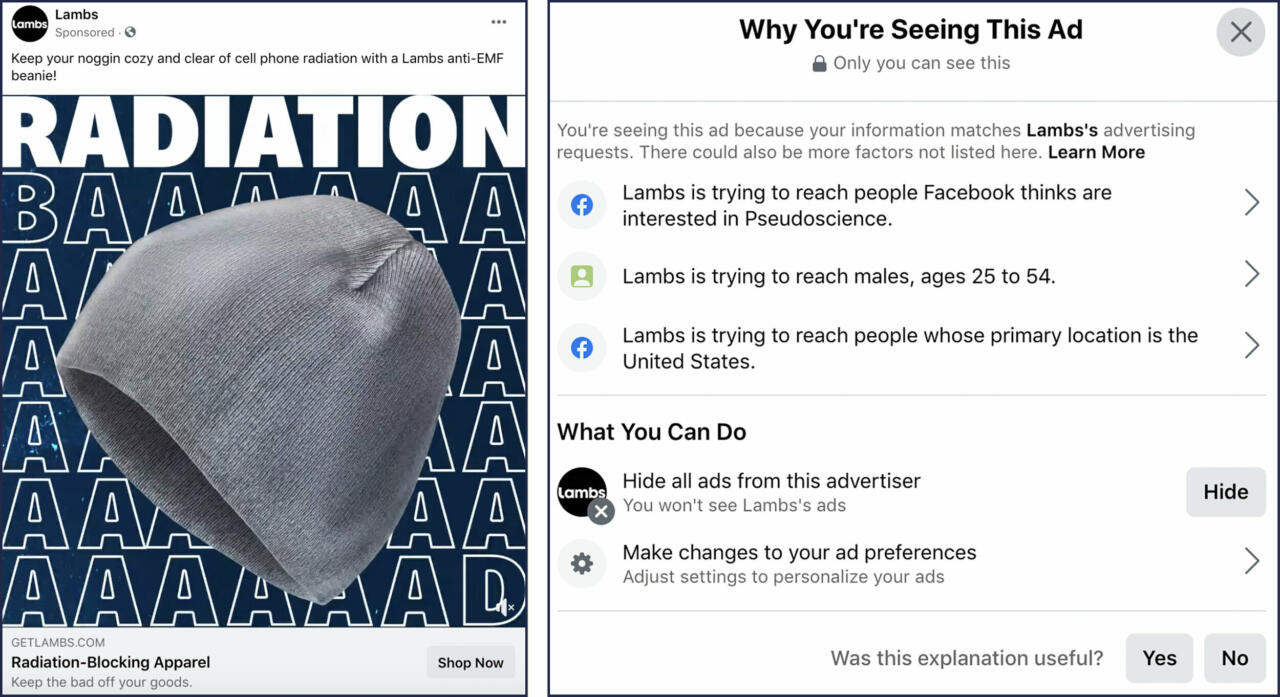Hello, friends,
On Tuesday, The Markup reporter Maddy Varner bought an ad on Facebook to promote this newsletter. Using Facebook’s microtargeting tool, she aimed the ad at people aged 18 to 65-plus who lived in the United States and were interested in “pseudoscience,” a category the company said included more than 78 million people worldwide.
We purchased the ad to verify that Facebook was indeed allowing advertisers to use this provocative targeting criterion.
The Markup reporter Aaron Sankin first spotted the ad category when he was shown an ad on Facebook (for a cellphone-radiation-blocking hat) because, according to a Facebook tool, he was “interested in Pseudoscience.” He wondered: Could that really be an ad category?
After all, Facebook has been promoting its efforts to clamp down on coronavirus misinformation. CEO Mark Zuckerberg had written a post about Facebook’s efforts to “limit the spread of misinformation about Covid-19” the same day Aaron saw the ad.
And yet it was true, as Maddy found: Facebook allows the sale of ads targeted at those “interested in Pseudoscience”—or it did, until Aaron asked about it, at which point the company immediately shut down the category, just as it shut down the “Jew hater” ad category after Maddy and I wrote about it in 2017. And just as it finally stopped allowing housing advertisers to discriminate by race after I wrote about it repeatedly in 2016 and 2017.
Facebook keeps winding up in the same situation because it competes to offer advertisers the most specific information possible about its users. The Markup reporter Surya Mattu and I created a crowd-sourced database of Facebook ad categories at ProPublica back in 2016 and found among them “Pretending to Text in Awkward Situations.” Looking back at the database this week, we found that “Pseudoscience” was one of the 52,000 categories we had identified at the time.
As Ian Bogost and Alexis Madrigal so eloquently wrote in a recent Atlantic piece, Facebook’s value for advertisers like Donald Trump is based primarily on its ability to know its users better than they know themselves.
But grouping users by their vulnerabilities, such as social awkwardness or fear-based susceptibility to scams, has an unsavory history. Lists of vulnerable people who could be targeted by junk mail scams were called “suckers lists” back in the old days.
Unfortunately, it’s difficult for outsiders to monitor Facebook for modern-day suckers lists because Facebook is a closed platform where each user sees only the information targeted at them. We caught the hat ad, for instance, because Aaron spotted it in his news feed.
Facebook has made efforts toward ad transparency. It built an advertising library for ads running live on Facebook and an archive of ads about “issues, elections or politics” that have appeared on Facebook. But nowhere does the library disclose how those ads were targeted.
Until there is another way, our best hope of finding out how vulnerable people are being targeted on Facebook is by buying ads in bizarre categories and seeing if they are approved—and by tips from you!
So, if you see something with weird targeting information in your Facebook News Feed (you can see that information by clicking on the top right corner of the ad and choosing the “Why Am I Seeing this Ad?” option), please send it our way at tips@themarkup.org.
And thanks, as always, for reading!
Best,
Julia Angwin
Editor-in-Chief
The Markup
